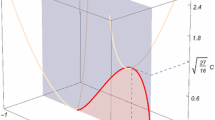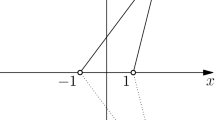Abstract
Shape dynamics is a completely background-independent universal framework of dynamical theories from which all absolute elements have been eliminated. For particles, only the variables that describe the shapes of the instantaneous particle configurations are dynamical. In the case of Riemannian three-geometries, the only dynamical variables are the parts of the metric that determine angles. The local scale factor plays no role. This leads to a shape-dynamic theory of gravity in which the four-dimensional diffeomorphism invariance of general relativity is replaced by three-dimensional diffeomorphism invariance and three-dimensional conformal invariance. Despite this difference of symmetry groups, it is remarkable that the predictions of the two theories – shape dynamics and general relativity – agree on spacetime foliations by hypersurfaces of constant mean extrinsic curvature. However, the two theories are distinct, with shape dynamics having a much more restrictive set of solutions. There are indications that the symmetry group of shape dynamics makes it more amenable to quantization and thus to the creation of quantum gravity. This introduction presents in simple terms the arguments for shape dynamics, its implementation techniques, and a survey of existing results.
Mathematics Subject Classification (2010). 70G75, 70H45, 83C05, 83C45.
Access this chapter
Tax calculation will be finalised at checkout
Purchases are for personal use only
Preview
Unable to display preview. Download preview PDF.
Similar content being viewed by others
References
E Mach. Die Mechanik in ihrer Entwickelung historisch-kritisch dargestellt. 1883.
E Mach. The Science of Mechanics. Open Court, 1960.
A Einstein. Prinzipielles zur allgemeinen Relativitätstheorie. Annalen der Physik, 55:241–244, 1918.
A Einstein. Dialog über Einwände gegen die Relativitätstheorie. Die Naturwissenschaften, 6:697–702, 1918.
J Barbour and H Pfister, editors. Mach’s Principle: From Newton’s Bucket to Quantum Gravity, volume 6 of Einstein Studies. Birkhäuser, Boston, 1995.
J Barbour. Absolute or Relative Motion? Volume 1. The Discovery of Dynamics. Cambridge University Press, 1989.
J Barbour. The Discovery of Dynamics. Oxford University Press, 2001.
I Newton. Sir Isaac Newton’s Mathematical Principles of Natural Philosophy. University of California Press, 1962.
H Gomes, S Gryb, and T Koslowski. Einstein gravity as a 3D conformally invariant theory (arXiv:1010.2481). Class. Quant. Grav., 28:045005, 2011.
H Gomes and T Koslowski. The link between general relativity and shape dynamics. arXiv:1101.5974.
J Barbour and B Bertotti. Mach’s principle and the structure of dynamical theories (downloadable from platonia.com). Proceedings of the Royal Society London A, 382:295–306, 1982.
J Barbour. Scale-invariant gravity: particle dynamics. Class. Quantum Grav., 20:1543–1570, 2003, gr-qc/0211021.
D Saari. Collisions, Rings, and Other Newtonian N-Body Problems. American Mathematical Society, Providence, Rhode Island, 2005.
H Poincaré. Science et Hypothèse. Paris, 1902.
H Poincaré. Science and Hypothesis. Walter Scott, London, 1905.
J Barbour. The definition of Mach’s principle (arXiv:1007.3368). Found. Phys., 40:1263–1284, 2010.
C Lanczos. The Variational Principles of Mechanics. University of Toronto Press, 1949.
P A M Dirac. Lectures on Quantum Mechanics. Belfer Graduate School of Science, Yeshiva University, New York, 1964.
H Weyl. Gravitation und Elektrizität. Sitzungsber. Preuss. Akad. Berlin, pages 465–480, 1918.
H Weyl. Gravitation and electricity. In Ó Raifeartaigh, editor, The dawning of gauge theory, pages 24–37. Princeton University Press, 1997.
P A M Dirac. Generalized Hamiltonian dynamics. Proc. R. Soc. (London), A246:326–343, 1958.
R Arnowitt, S Deser, and C W Misner. The dynamics of general relativity. In L Witten, editor, Gravitation: An Introduction to Current Research, pages 227–265. Wiley, New York, 1962.
B F Schutz. Geometrical Methods of Mathematical Physics. Cambridge University Press, Cambridge, 1980.
C W Misner, K S Thorne, and J A Wheeler. Gravitation. W H Freeman and Company, San Francisco, 1973.
K Kuchař. Time and interpretations of quantum gravity. In G Kunstatter, D Vincent, and J Williams, editors, Proceedings 4th Canadian Conf. General Relativity and Relativistic Astrophysics, pages 211–314. World Scientific, Singapore, 1992.
C J Isham. Canonical quantum gravity and the problem of time. In L A Ibort and M A Rodríguez, editors, Integrable Systems, Quantum Groups, and Quantum Field Theory, pages 157–287. Kluwer, Dordrecht, 1993.
J Barbour. The End of Time. Weidenfeld and Nicolson, London; Oxford University Press, New York, 1999.
J Barbour, B Z Foster, and N Ó Murchadha. Relativity without relativity. Class. Quantum Grav., 19:3217–3248, 2002, gr-qc/0012089.
E Anderson. On the recovery of geometrodynamics from two different sets of first principles. Stud. Hist. Philos. Mod. Phys., 38:15, 2007. arXiv:grqc/ 0511070.
E Anderson. Does relationalism alone control geometrodynamics with sources? 2007. arXiv:0711.0285.
R Baierlein, D Sharp, and J Wheeler. Three-dimensional geometry as a carrier of information about time. Phys. Rev., 126:1864–1865, 1962.
E Anderson and J Barbour. Interacting vector fields in relativity without relativity. Class. Quantum Grav., 19:3249–3262, 2002, gr-qc/0201092.
A Einstein. Zur Elektrodynamik bewegter Körper. Ann. Phys., 17:891–921, 1905.
H Poincaré. La mesure du temps. Rev. Métaphys. Morale, 6:1, 1898.
H Poincaré. The measure of time. In The Value of Science. 1904.
A Einstein. Autobiographical notes. In P Schilpp, editor, Albert Einstein: Philosopher–Scientist. Harper and Row, New York, 1949.
H Weyl. Symmetry. Princeton University Press, 1952.
J Barbour and N Ó Murchadha. Classical and quantum gravity on conformal superspace. 1999, gr-qc/9911071.
E Anderson, J Barbour, B Z Foster, and N Ó Murchadha. Scale-invariant gravity: geometrodynamics. Class. Quantum Grav., 20:1571, 2003, gr-qc/0211022.
E Anderson, J Barbour, B Z Foster, B Kelleher, and N Ó Murchadha. The physical gravitational degrees of freedom. Class. Quantum Grav., 22:1795–1802, 2005, gr-qc/0407104.
J Barbour and N Ó Murchadha. Conformal Superspace: the configuration space of general relativity, arXiv:1009.3559.
A Einstein. The Meaning of Relativity. Methuen and Co Ltd, London, 1922.
J W York. Gravitational degrees of freedom and the initial-value problem. Phys. Rev. Letters, 26:1656–1658, 1971.
J W York. The role of conformal 3-geometry in the dynamics of gravitation. Phys. Rev. Letters, 28:1082–1085, 1972.
J Isenberg, N Ó Murchadha, and J W York. Initial-value problem of general relativity. III. Phys. Rev. D, 12:1532–1537, 1976.
J Isenberg and J Nester. Extension of the York field decomposition to general gravitationally coupled fields. Ann. Phys., 108:368–386, 1977.
Author information
Authors and Affiliations
Corresponding author
Editor information
Editors and Affiliations
Rights and permissions
Copyright information
© 2012 Springer Basel AG
About this chapter
Cite this chapter
Barbour, J. (2012). Shape Dynamics. An Introduction. In: Finster, F., Müller, O., Nardmann, M., Tolksdorf, J., Zeidler, E. (eds) Quantum Field Theory and Gravity. Springer, Basel. https://doi.org/10.1007/978-3-0348-0043-3_13
Download citation
DOI: https://doi.org/10.1007/978-3-0348-0043-3_13
Published:
Publisher Name: Springer, Basel
Print ISBN: 978-3-0348-0042-6
Online ISBN: 978-3-0348-0043-3
eBook Packages: Mathematics and StatisticsMathematics and Statistics (R0)




